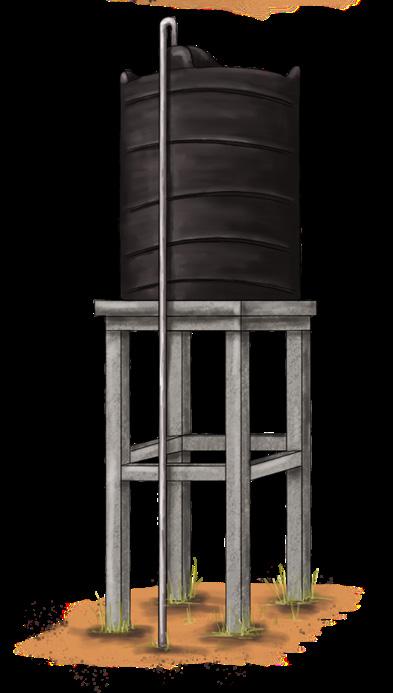Water tank protection
Different
physical barriers can help protect water points from elephant damage.

Method 1 : water towers



This can be a metal, concrete or wooden structure, at least 3 metres high.
Make sure the foundations are strong and the structure is sturdy enough to be able to hold the weight of a full water tank.

Depending on the size of the water installation, the higher the tank, the better protected it may be from elephants.
Make sure there is a ladder and safe human access.
combination of helps increase the water point Use sharp white rock barriers to add extra protection water pipes


During the dry season or times of drought, elephants and humans may come into conflict over resources - like water
Method 2 : White rock barriers



This is a barrier of sharp rocks, painted white. This can be used to help fortify fences or farm enclosures.
Method 3 : Stone walls



Wall should be smooth to prevent elephants from climbing over.
unpleasant elephants to walk on.
This method is being used in Namibia to help with conflict over water sources with desert elephants

MATERIAL CHECKLIST
Paint brushes

Method 2 : White rock barriers
Process
for your rock
Cleaning solution for brushes (e.g Turpentine or petrol)

White paint

Large sharp rocks (Natural white rocks can also be used)

Physical labour
Vegetation around the rocks must be cleared as they can be used as a cushion by elephants to step over.

Create a barrier at least 3-4 metres wide.
Lay them out in front of the area you wish to protect
Make sure the sharp side is facing upwards.

Stones must be tightly compacted together. Elephants can lay them flat by pushing them over.


Leave a 1 to 2 metre gap between the water tank and the start of the white rock barrier.
all the rocks white. This will help reflect the sun and will for elephants

1-2 meters
If the rock surfaces get dirty by elephants attempting to climb over, make sure to wipe the dirt off to retain white/shiny surface.





Combine with cement cones within white rocks for added effectiveness.


Method 3 : Stone walls
MATERIAL CHECKLIST Process
Mark the ground.
Make sure there is at least 3-4m between the water installation and the wall to ensure elephants cannot reach over it.
Dig the foundation at least 0.5 metres deep and 1 metre wide.
Caution tips: These are physically intensive to build
May require professional help for transport and construction.




Elephants may still risk pain in the pursuit of tasty crops or water sources, especially during the dry season, so using combined methods will increase the effectiveness of protection methods.
Take care of safety when accessing the water towers

cement in a spade of spades of sand and water thick











Lay the bricks. Build the wall at least 2 metres high
2 meters

Credits and Disclaimer:
The Stone wall and White Rock barrier ideas were developed by Elephant Human Relations Aid (EHRA), Namibia. More information: www.ehranamibia.org Water tower design adapted from similar protection methods. For literature and resources used, see References More research may be required before each site-specific implementation. Safety and caution is advised with all the methods presented in this toolbox.


*Save the Elephants is not liable for any costs, damages or injuries incurred by the use of these methods.

Leave a small space for people to access the water tanks.

 40 bags of cement Spade
40 bags of cement Spade
